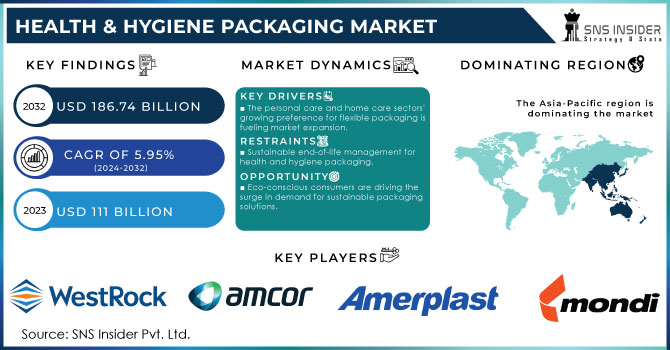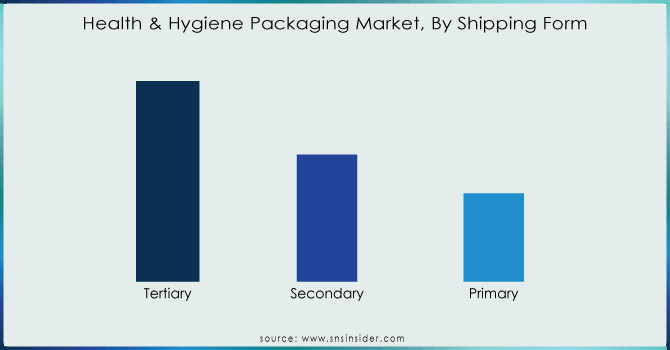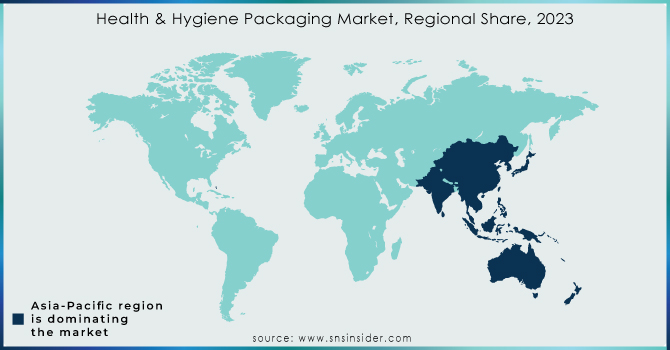Health & Hygiene Packaging Market Report Scope & Overview:

Get More Information on Health & Hygiene Packaging Market - Request Sample Report
The Health & Hygiene Packaging Market Size was valued at USD 111 billion in 2023 and is projected to reach USD 186.74 billion by 2032 growing at a CAGR of 5.95% from 2024 to 2032.
Heightened awareness of hygiene and the rise of convenient, portable products are fueling demand. Concerns about contamination and food safety further emphasize the need for secure packaging. The COVID-19 pandemic significantly accelerated this trend, as sanitization products and protective gear became essential. Technological advancements like biodegradable materials and smart packaging solutions are enabling the creation of packaging that is not only safe but also sustainable.
This market is particularly promising in regions like India, with its growing healthcare sector and increasing government investment in public health. The Indian government significantly boosted its budget allocation for health and well-being in the Union Budget 2021-22, allocating INR 2,23,846 crore, a substantial hike from the previous year's INR 94,452 crore. As the importance of hygiene and safety rises globally, the health and hygiene packaging market is well-positioned to thrive.
MARKET DYNAMICS
KEY DRIVERS:
-
The personal care and home care sectors' growing preference for flexible packaging is fueling market expansion.
Flexible packaging is taking over the personal care and home care shelves. This rise in popularity is due to its many benefits. Flexible pouches and containers can fit all shapes and sizes, making them perfect for different products. They're also lightweight, saving space and reducing shipping costs. Plus, they're easy to open and reclose, keeping your favorite shampoo or laundry detergent fresh. No wonder the flexible packaging market is booming.
-
The increasing importance of preventive healthcare is leading to a heightened focus on health awareness.
RESTRAINTS:
-
Sustainable end-of-life management for health and hygiene packaging.
High material costs and limited recycling options are making it tough for hygiene packaging companies to compete. Plastic prices are rising, and key parts like polypropylene are hard to find. Plus, most hygiene packaging can't be easily recycled because it's made of different layers stuck together. This is bad for the environment and makes recycling slow and expensive. The hygiene packaging industry needs to find ways to make packaging cheaper and easier to recycle to keep growing.
-
Developing safe and hygienic packaging solutions can be a financial hurdle.
OPPORTUNITY:
-
Eco-conscious consumers are driving the surge in demand for sustainable packaging solutions.
Eco-conscious brands are revamping their packaging. Growing concerns about the environment are pushing them to ditch excess plastic and embrace sustainable practices. This means designing smaller, lighter packages that require less space to transport, a win-win for the planet and shipping costs. It's also a response to consumers' demand for eco-friendly products. With hygiene a top priority these days, this trend is particularly hot in the flexible packaging market.
-
Consumers are increasingly demanding stricter safeguards against contamination throughout the food supply chain.
CHALLENGES:
-
Advanced technology is revolutionizing Health & Hygiene packaging, bringing exciting new features and functionalities.
Flexible packaging is getting a high-tech makeover. New technology is making it possible to add cool features like built-in inventory trackers and product monitors, which means less manual work for everyone. But that's not all! Manufacturers are also creating eye-catching designs that appeal to a wider range of consumers. This focus on both smart tech and shelf appeal shows how flexible packaging is innovating to keep up with what people want and what technology allows.
-
Strict regulations for health and hygiene packaging prioritize the safety of consumers and the integrity of the products.
IMPACT OF RUSSIA UKRAINE WAR
The war in Ukraine disrupts the health and hygiene packaging market in two main ways. Firstly, Ukraine is a key supplier of raw materials like polymers and resins. The conflict creates bottlenecks, shortages, and price hikes for these materials, impacting global availability and driving up costs for manufacturers. Secondly, the war's instability leads to currency fluctuations and commodity price variations, making production and transportation more expensive. These factors combine to push up the final price of health and hygiene packaging products, squeezing both manufacturers and consumers. However, the war also creates a countervailing force. Humanitarian crises caused by the conflict, such as displaced populations and damaged healthcare facilities, heighten the need for essential hygiene products. This could lead to a rise in demand for specialized packaging solutions designed for humanitarian aid efforts.
IMPACT OF ECONOMIC SLOWDOWN
Lower consumer spending might lead to a drop in demand for non-essential personal care and home care products, impacting packaging needs. This could force companies to choose cheaper packaging options, potentially putting a strain on innovation and sustainable solutions. Even though hygiene products are essential, consumers may switch to budget-friendly alternatives, further affecting market dynamics. The over-the-counter (OTC) pharmaceutical market could also see changes in buying habits, impacting the types and amounts of packaging needed.
KEY MARKET SEGMENTS
By Product Type
-
Films and sheets
-
Bags & Pouches
-
laminates, labels
-
Jars & Bottles
-
Sachets
-
boxes and cartons
-
Others
The health and hygiene packaging market is a diverse bunch, with films and sheets reigning supreme with 57.5% of market revenue. This dominance is due to their versatility and protective qualities. They keep healthcare, hygiene, and pharmaceutical products safe from moisture, oxygen, and other threats. Plus, they can be customized with anti-counterfeiting features and tamper-evident designs for extra security. Furthermore, the rise of single-use, convenient packaging like sachets is fueling the demand for these films and sheets even more.
By Form
-
Rigid Packaging
-
Molding
-
Extrusion
-
Others
-
Flexible Packaging
-
Single Layer
-
Multi-Layer
Flexible packaging holds dominance with 57% of the market revenue. This popularity is due to its lightweight design, ability to bend and conform, and affordability. Plus, advancements in this area are creating innovative and user-friendly options for both consumers and healthcare professionals. Think stand-up pouches and resealable packages are convenient and keeping products fresh.
By Structure
-
Porous
-
Non-porous
In health and hygiene packaging, keeping things clean and secure is top priority That's why non-porous packaging is dominating, holding 62% of the market. This type of packaging is especially important for medical supplies, medicine, and personal care items. It blocks out germs and keeps products safe from tampering, making sure they reach consumers in perfect condition. With stricter regulations and people wanting extra protection, non-porous packaging is a must-have for the health and hygiene industry.
By Shipping Form
-
Primary
-
Secondary
-
Tertiary
The health and hygiene packaging market is all about protecting products for their journey to consumers. The tertiary packaging segment is the biggest at 60% of the market revenue. This is because hospitals and healthcare companies are looking for eco-friendly ways to package things. Tertiary packaging companies are stepping up by creating sustainable solutions that keep products safe without harming the environment.

Do You Need any Customization Research on health and hygiene packaging market - Enquire Now
By Distribution Channel
-
Hypermarkets/Supermarkets
-
Online Retailers
-
Direct Sales
-
Others
Direct sales reign supreme in health and hygiene packaging, capturing 61% of the market revenue. This distribution channel thrives on its ability to tailor products to individual needs. Unlike one-size-fits-all options found in stores, direct sales cater to specific preferences in the health and hygiene industry. Here, customers often have unique requirements when it comes to product formulas, packaging sizes, and designs. Direct sales channels meet these diverse needs through customization and personalization, ensuring customers get exactly what they're looking for.
REGIONAL ANALYSIS
The Asia-Pacific region is expected to dominate the health and hygiene packaging market with China and India leading the regional market. This growth is fueled by a booming population, growing healthcare sectors, and a rising focus on hygiene. India's impressive digital healthcare infrastructure and China's established market presence further solidify Asia-Pacific's position as a leader in this sector. Additionally, the surge of e-commerce in the region is driving demand for convenient and hygienic packaging solutions, propelling the market to even greater heights.
Europe commands the second-largest slice of the health and hygiene packaging pie, fueled by constant technological advancements. The UK, a leader in this space, boasts an impressive packaging industry that generates billions in sales and employs a significant portion of its workforce. Manufacturers are pouring resources into R&D, focusing on innovative materials that offer superior protection against contamination, leakage, and tampering. One such breakthrough is the rise of antimicrobial packaging, ensuring the safety and integrity of hygiene products. Notably, Germany holds the largest market share within Europe, while the UK is experiencing the fastest growth.

REGIONAL COVERAGE:
North America
-
US
-
Canada
-
Mexico
Europe
-
Eastern Europe
-
Poland
-
Romania
-
Hungary
-
Turkey
-
Rest of Eastern Europe
-
-
Western Europe
-
Germany
-
France
-
UK
-
Italy
-
Spain
-
Netherlands
-
Switzerland
-
Austria
-
Rest of Western Europe
-
Asia Pacific
-
China
-
India
-
Japan
-
South Korea
-
Vietnam
-
Singapore
-
Australia
-
Rest of Asia Pacific
Middle East & Africa
-
Middle East
-
UAE
-
Egypt
-
Saudi Arabia
-
Qatar
-
Rest of Middle East
-
-
Africa
-
Nigeria
-
South Africa
-
Rest of Africa
-
Latin America
-
Brazil
-
Argentina
-
Colombia
-
Rest of Latin America
Key players
Some of the major players in the Health & Hygiene Packaging Market are Amcor Plc, Mondi Group, WestRock, Sonoco Products Company, Amerplast Ltd, Kimberly Clark, Berry Global, Comar Packaging Solutions, Glenroy, Inc, Essity And Others Players.
RECENT DEVELOPMENTS
-
Berry Global partnered with PYLOTE in October 2022 to launch a novel multi dose eye dropper boasting high barrier and antimicrobial protection.
-
Amcor launched Dairy Seal in September 2022. This innovative PET packaging line with ClearCor technology caters to the growing needs of the RTD, dairy alternatives, and nutritional markets.
| Report Attributes | Details |
|---|---|
| Market Size in 2023 | US$ 111 Bn |
| Market Size by 2032 | US$ 186.74 Bn |
| CAGR | CAGR of 5.95% From 2024 to 2032 |
| Base Year | 2023 |
| Forecast Period | 2024-2032 |
| Historical Data | 2020-2022 |
| Report Scope & Coverage | Market Size, Segments Analysis, Competitive Landscape, Regional Analysis, DROC & SWOT Analysis, Forecast Outlook |
| Key Segments | • By Product Type(Films And Sheets, Bags & Pouches, Laminates, Labels, Jars & Bottles, Sachets, Boxes And Cartons, Others) • By Form[ Rigid Packaging (Molding, Extrusion, Others), Flexible Packaging (Single Layer, Multi-Layer)] • By Structure (Porous, Non-Porous) • By Shipping Form (Primary, Secondary, Tertiary) • By Distribution Channel (Hypermarkets/Supermarkets, Online Retailers, Direct Sales, Others) |
| Regional Analysis/Coverage | North America (US, Canada, Mexico), Europe (Eastern Europe [Poland, Romania, Hungary, Turkey, Rest of Eastern Europe] Western Europe] Germany, France, UK, Italy, Spain, Netherlands, Switzerland, Austria, Rest of Western Europe]), Asia Pacific (China, India, Japan, South Korea, Vietnam, Singapore, Australia, Rest of Asia Pacific), Middle East & Africa (Middle East [UAE, Egypt, Saudi Arabia, Qatar, Rest of Middle East], Africa [Nigeria, South Africa, Rest of Africa], Latin America (Brazil, Argentina, Colombia Rest of Latin America) |
| Company Profiles | Amcor Plc, Mondi Group, WestRock, Sonoco Products Company, Amerplast Ltd, Kimberly Clark, Berry Global, Comar Packaging Solutions, Glenroy, Inc, Essity |
| Key Drivers | • The personal care and home care sectors' growing preference for flexible packaging is fueling market expansion. • The increasing importance of preventive healthcare is leading to a heightened focus on health awareness. |
| Key Restraints | • Sustainable end-of-life management for health and hygiene packaging. • Developing safe and hygienic packaging solutions can be a financial hurdle. |

